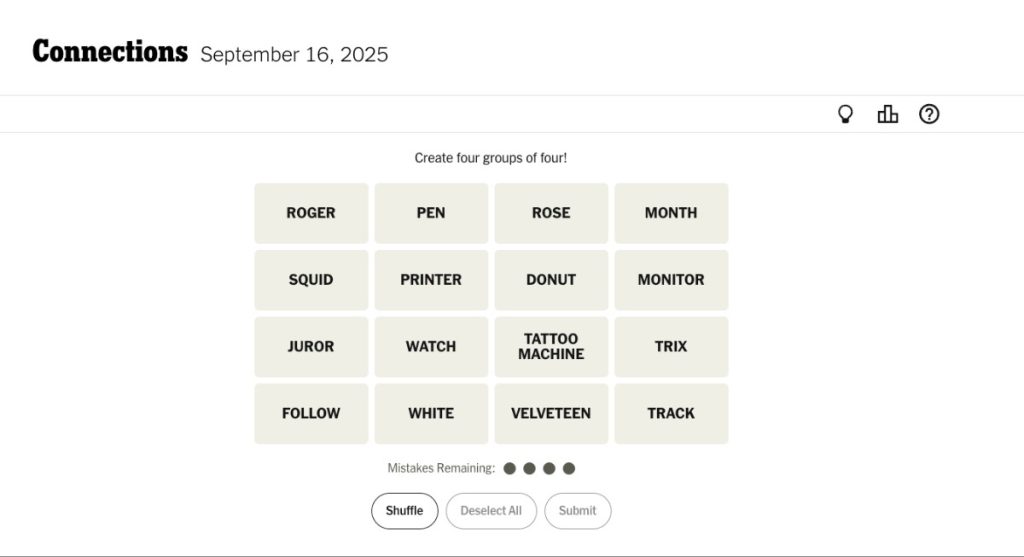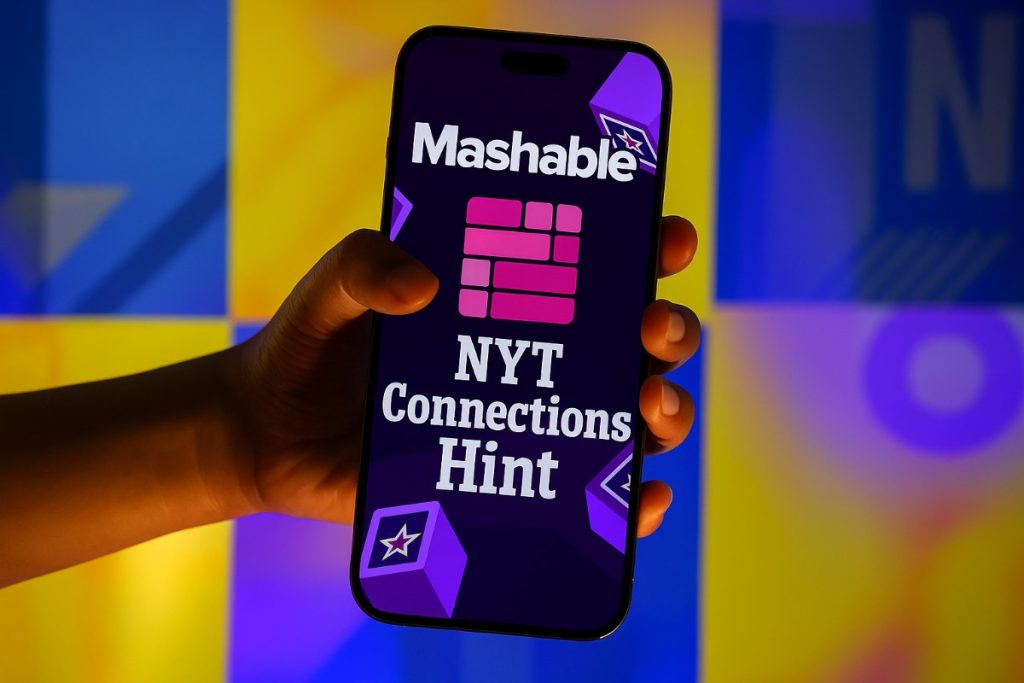Mashable Connections Hint has become the first stop for thousands of puzzle lovers who need a nudge with today’s NYT Connections.
Facing a grid of tricky words, many fans turn to Mashable’s hints each morning because they want a gentle clue to keep their streak alive without giving away the solution or spoiling their fun.
For those who love NYT Connections or just want to get better at solving word puzzles, Mashable’s daily hint system promises just enough help to get your brain pointed in the right direction. The hints arrive fresh every day, always tiered from broad to specific, so anyone can decide the amount of guidance needed.
Mashable’s hints have become popular with puzzle fans because they help people solve puzzles faster and smarter, without giving away the answers. Regular users know they will get general hints first, and only more specific help if they need it. Mashable’s step-by-step hints make playing Connections feel friendly and fun, supporting both beginners and experienced players who want to win.
Why Mashable Offers Connections Hints
Mashable offers Connections hints because solving NYT Connections can be tricky, and not everyone wants the whole answer given away. The hints make the game more fun for everyone. They give just enough help to keep players moving forward without giving away the answers.
Many players get stuck on certain groups of words or frustrated by hidden connections. Mashable saw this need and created a system of tiered clues. Every day, fresh hints help players by first giving general clues, like “things that fly.” If more help is needed, the hints get a little more specific without giving away the answer. This way, players can choose how much help they want, which makes the game feel fair and friendly for everyone.
The main reason Mashable’s hints work so well is that they promote learning and confidence. The clues help players spot patterns, avoid common errors, and understand the puzzle’s logic. With hints, players get to enjoy the fun of discovery and the satisfaction of figuring things out, even if they need a little guidance along the way.
The daily hint ritual also brings people together and builds a friendly community around the game, keeping the challenge enjoyable for everyone.
What is NYT Connections?

NYT Connections is a daily word puzzle from The New York Times that asks people to find secret links between words. Each puzzle consists of a 4×4 grid filled with 16 words. The main goal is to sort these words into four neat groups, with each group sharing a special connection.
For example, four words might all be fruits, types of dogs, or names of colors. The catch is that each word fits into only one group, and every puzzle has just one perfect solution.
People play by tapping or clicking on four words they think belong together, then submitting their guess. When a group is correct, the puzzle labels it with a color that shows its difficulty: yellow is easiest, green and blue range in the middle, and purple is usually the most challenging.
The categories can get clever, sometimes using puns, tricky spellings, or words that sound alike. Games editors pick the categories to keep things interesting and surprising on every new day.
Besides spotting word connections, the puzzle adds excitement by allowing only four mistakes while solving.
If someone picks a wrong group, they lose a “life.” If all four tries are gone, the puzzle ends and shows the solutions. There is also a shuffle button, which changes the position of the words that gives players a fresh look and sometimes helps spot a pattern they missed earlier.
When the puzzle is done, the groups appear clearly labeled, which reveals all the links and allows people to see which connections they got or missed. Many friends and family members share results and talk about the categories each day, and NYT Connections becomes a mini-challenge that everyone looks forward to solving together.
Why People Love Playing
Connections took off almost overnight after its launch in 2023. It quickly became the Times’ second most popular game, right behind Wordle. Players enjoy it for many reasons:
- The challenge feels fair—sometimes tricky, but rarely impossible.
- Daily play brings a sense of routine and accomplishment.
- Its quirky word groups spark lively debates and friendly competition.
Success in NYT Connections comes from both smart thinking and sharp observation. Players who do well notice details, stay patient, and use a plan. Some important principles help people solve the puzzle and feel that wave of excitement with each victory.
NYT Connections Principles: What Drives Success?
Success in NYT Connections comes from both smart thinking and sharp observation. Players who do well notice details, stay patient, and use a plan. Some important principles help people solve the puzzle and feel that wave of excitement with each victory.
Pay Attention to Patterns
The heart of Connections is to look for patterns. The best players start by searching for shared meanings, word endings, or types. Sometimes four words are all animals or things you find at school. Other times, they sound alike or have a funny link no one expects.
Avoid the Obvious Trap
Connections likes to trick people with easy matches. Just because four words look like one group, that does not always mean they belong together. Many times, a word could fit in more than one category, and the real groupings hide just out of sight. It’s smart to rethink “easy” solutions before locking them in.
Use Color to Judge Difficulty
Each group has a different level of difficulty, marked by colors—yellow for easy, green and blue for middle, purple for the hardest. Start with yellow to build confidence, then move to the trickier sets. Knowing the color order helps players focus their efforts and spot which group might be missing.
Shuffle for Fresh Ideas
When stuck, the shuffle feature can reveal new group ideas. Rearranging the board often unlocks patterns that remained hidden. Some fans like to shuffle first, while others prefer the original layout, but both methods help people look at words in new ways.
Be Careful With “One Away” Hints
If the puzzle says, “One away,” many people make the mistake of quickly swapping one word. A smart trick is to pause and review the entire set. Sometimes, trading out more than just the obvious odd word fixes the mistake and leads to the right match.
Practice and Learn From Each Game
Each puzzle teaches a lesson. Over time, people notice the editor’s favorite tricks and themes. Regular play sharpens skills and encourages new ways to think about words and their connections. You can share results with friends to open up fun discussions and help everyone improve.
Connecting words in NYT Connections means seeing what hides beneath the surface. Use logic and a bit of creativity. Players who enjoy the journey, not just the final answer, get the most out of every game.
How to Solve Connections Quickly and Confidently
Solving NYT Connections quickly and with confidence depends on a smart, step-by-step approach. Each grid comes with its own surprises, but clear strategies help even beginners move toward a win.
Begin With the Obvious Connections
Always look over the whole word grid, scanning for the easiest and most familiar group. Words that fit together clearly—such as names of countries, animals, or sports—often belong to the yellow or green sets. Once you clear out the obvious groups, it becomes much easier to see the less obvious patterns in the remaining words.
Check Each Word for Hidden Meanings
When no group jumps out, choose a single word and look for any way it might link to the rest. Words with several meanings, like “bank” or “pitcher”, might be part of a trickier, blue or purple group that relies on wordplay or double meanings. When you search for clever or surprising connections, you can often crack open the tougher categories.
Use the Shuffle Feature for a Fresh Look
Sometimes staring at the same grid makes it hard to spot the connections.When you press the shuffle button, all the words move, which creates a new view and sometimes reveals themes that were not obvious before.
Say the Words Out Loud or Write Them Down
Reading words out loud or writing them on paper gives the brain a new way to recognize links. Some players find that hearing and seeing words in different ways brings ideas that a quiet scan does not.
Take Short Breaks When Stuck
If a solution just will not appear, step away for a few minutes. Coming back with a fresh mind can reveal a group that looked impossible before. Many players say even a short pause can make all the difference.
Practice Trivia and Stay Curious
Some groups rely on trivia or special knowledge, such as band names, brand names, or cultural references. Curiosity and regular practice with trivia games help build a stronger knowledge base and make more connections noticeable. Successful solving happens when you use different strategies, study each word carefully, and feel confident trying bold guesses. The real enjoyment comes from learning throughout the process, and each win improves your skills for future puzzles.
Common Mistakes and How to Avoid Them
People often trip up in NYT Connections because the game throws in plenty of tricks. Knowing what goes wrong can help avoid losing lives and boost your score. Below are details about the most common mistakes and simple ways to sidestep them.
Fall for Obvious Groups Too Fast
Some sets seem clear right away, like four colors, foods, or animals, but those easy groups can actually hide red herrings. Many times the obvious solution is just there to distract. Before submitting a group, double check that every word truly belongs and does not fit just as well somewhere else. Sometimes, the most “obvious” words get split among different categories.
Overstuff Groups
Another mistake happens when you spot five or six words that could fit together, instead of the needed four. NYT Connections always has exactly four words for each group. If extras pop up, test each one for a different connection. Try pairing each “extra” word with words outside of the big group—often, the overlap leads to discovering two different categories at once.
Ignore Trick Words and Double Meanings
The puzzle loves to use words with more than one meaning. Missing out on double meanings—such as “pitcher” (baseball or water jug)—can throw off your logic. When a word doesn’t seem to work anywhere, read it in a new way or think about homonyms, puns, or cultural references the editor might use.
Not Use the Shuffle Feature
The brain can get stuck in one way of thinking if you look at the board too long with the words in the same position. A quick press of the shuffle button moves the words around and often helps new ideas stand out.
If the shuffle only adds confusion, take a break and come back with fresh eyes.
Rush and Use Up All Mistakes Early
Connections gives just four mistakes. Quick guesses at the start or feeling frustrated can use up your chances before you reach the hardest connections. Many fans wait until they feel confident before locking in a set and make their guesses slowly and carefully. When you feel stuck, keep in mind that every choice matters and staying patient improves your odds of winning without losing all your lives.
Lose Track of Your Choices
Sometimes players forget which sets of words they already tried, especially if jumping around the board. A written list or a brief review of which words have not been matched yet helps keep track of your tries and prevents repeated mistakes.
How to Use Mashable’s Connections Hints for Best Results
Mashable’s Connections hints become much more helpful when used in the right way. Anyone can make the most of these hints by following some easy steps and understanding how the tiered system works.
Start by Trying the Puzzle Yourself
Spend a few minutes with today’s NYT Connections puzzle before looking at any hint. Searching for the easiest groups and reading each word carefully will help your brain begin to notice patterns more quickly.
Use the Mashable Hints Page for Today
Open Mashable’s daily hints page that matches the puzzle date. Every day brings a fresh batch of hints, listed in order to suit the exact puzzle you are trying to solve.
Begin With the Broadest Hint
At the top of Mashable’s hints, you will find very general clues. These usually mention a broad theme, like “music” or “things that fly,” but do not name any words. After reading the broadest clue, scan your word grid again. This often brings an “aha!” moment without giving anything away.
Move to More Specific Hints if Needed
If you still feel stuck, scroll down for the next level of hints. Each step becomes a bit more focused, sometimes describing tricky groups, warning about red herrings, or highlighting differences that set real categories apart from lookalikes.
Treat Each Hint as a Learning Tool
Hints work best when used after you have already tested your own ideas. Mistakes and “near misses” in your guesses will help you learn faster. Then, using just enough help from Mashable, you will spot your errors sooner and discover why certain groups succeed.
Let the Hints Support Your Game
Mashable’s style lets you decide how much help you want. Try not to rush through all the hints. Take your time and enjoy each level. With more practice, you will rely on hints less, but having them available means you never have to quit out of frustration.





